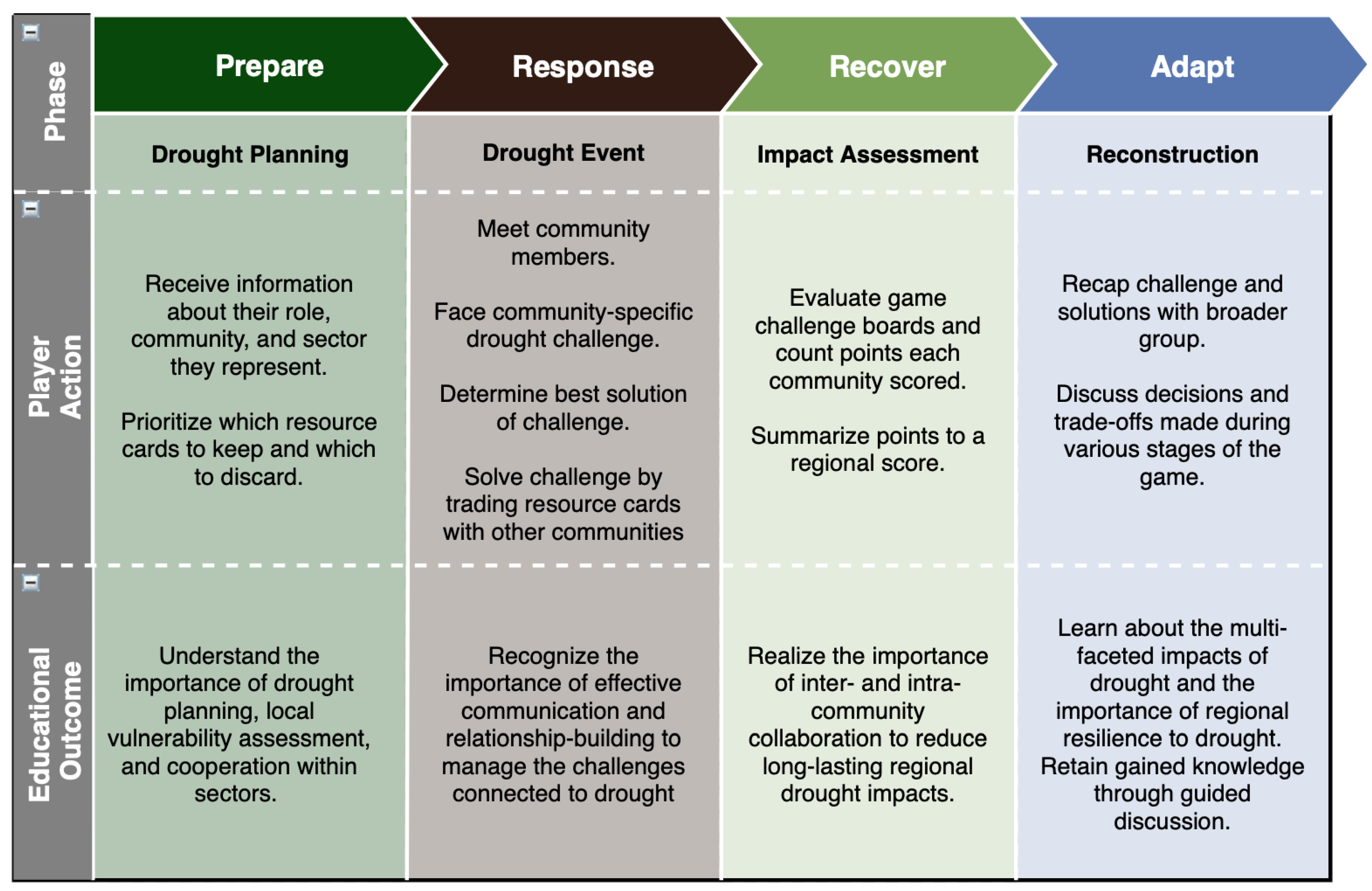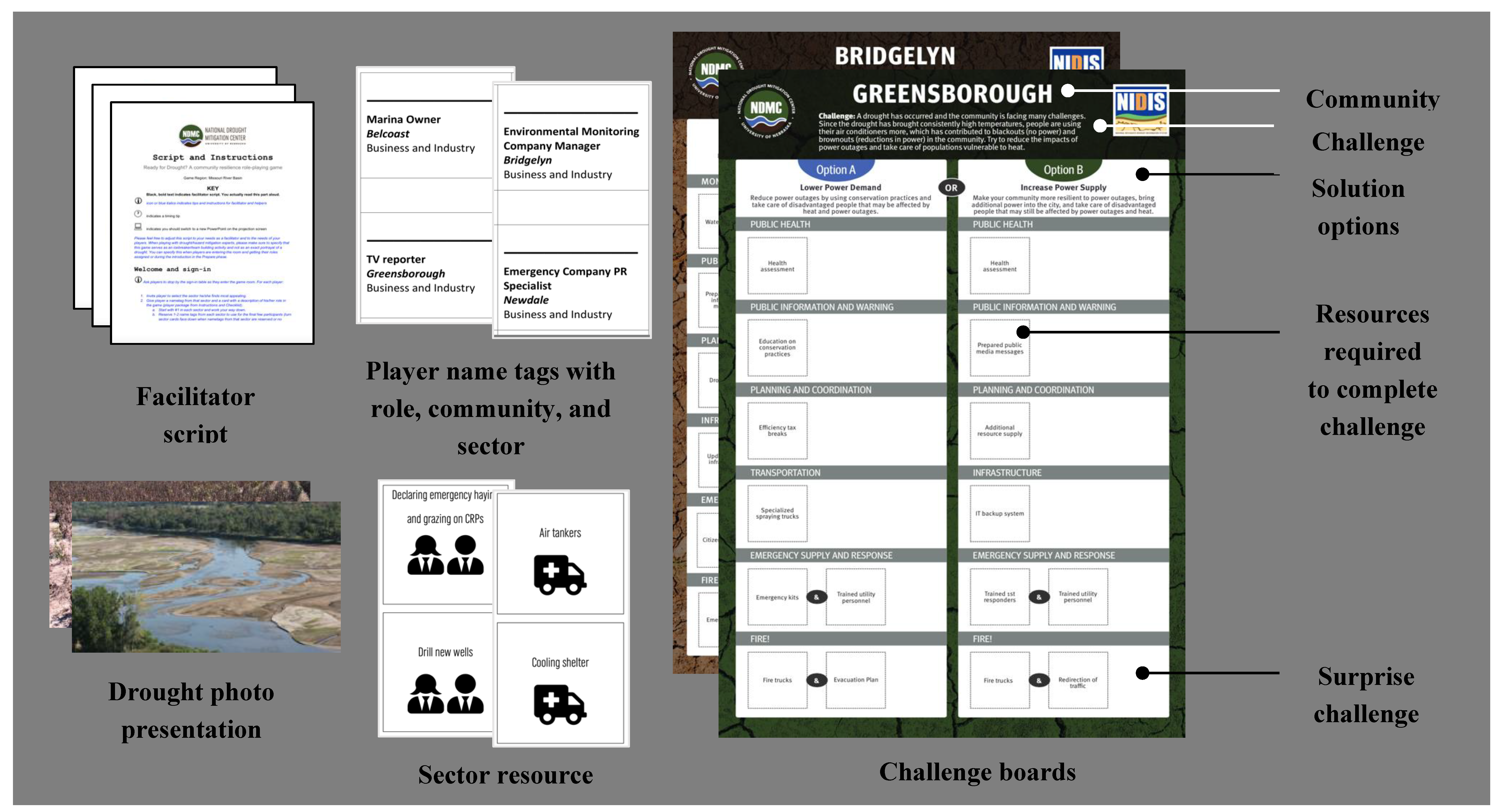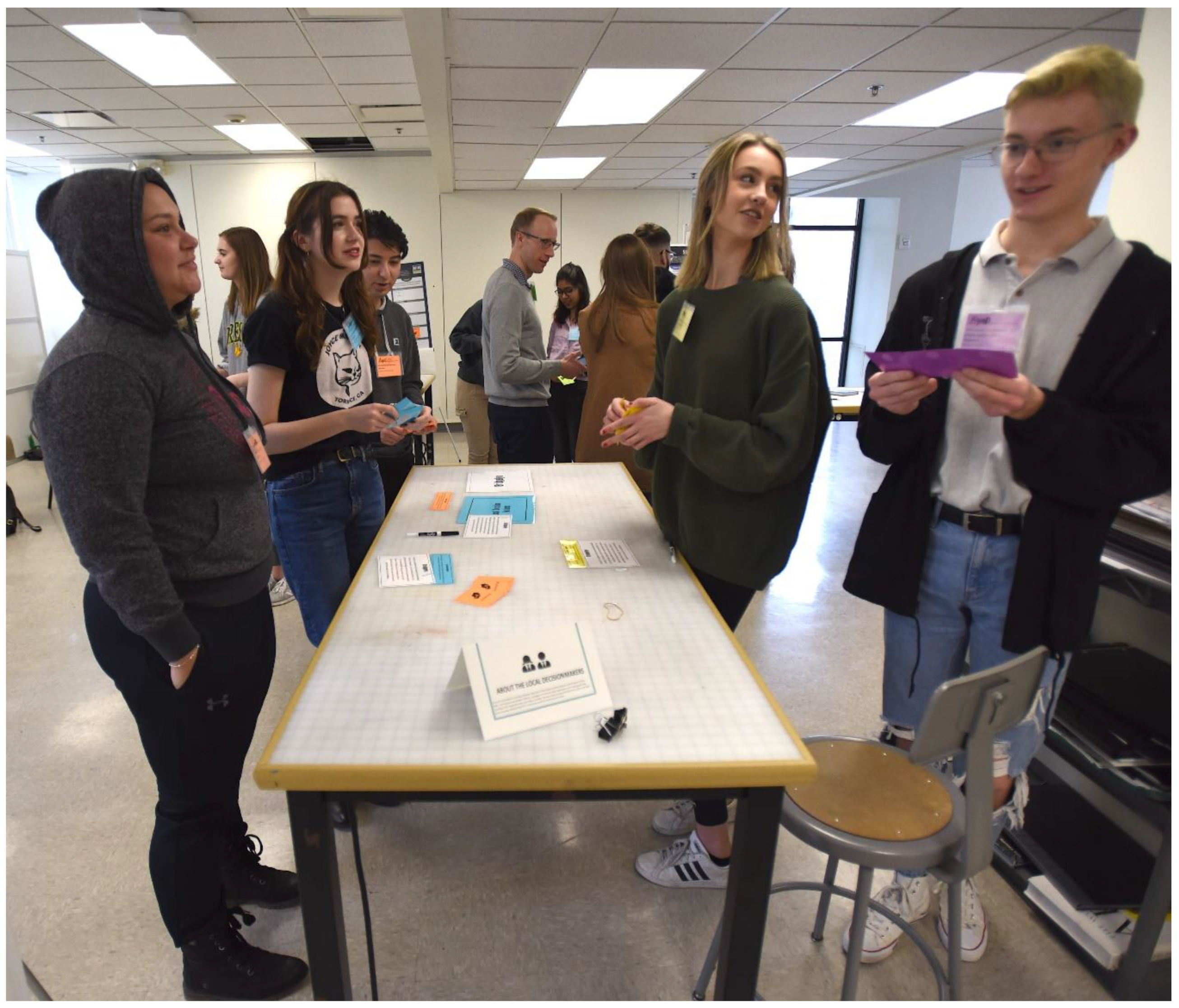Ready for Drought? A Community Resilience Role-Playing Game
Abstract
1. Introduction
2. Framework
2.1. Serious Games
2.2. Games and Learning
2.3. Games and Drought Planning
2.4. Objectives
3. Materials and Methods
3.1. Game Development Process
3.1.1. Location
3.1.2. Communities
3.1.3. Surprise Challenge
3.2. Game Description
3.2.1. Prepare Phase
3.2.2. Response Phase
3.2.3. Recover Phase
3.2.4. Adapt Phase
3.3. Assessment Methods
3.4. Adaptation to Other Regions
4. Results and Outcomes
Participant Survey
- Does the game serve as an effective icebreaker or team building activity?
- Does the game serve as an effective drought impact and planning educational tool?
- Does the game build awareness of the importance of communication, collaboration, and networking among stakeholders?
5. Discussion and Conclusions
Supplementary Materials
Author Contributions
Funding
Acknowledgments
Conflicts of Interest
References
- Rittel, H.W.J.; Webber, M.M. Dilemmas in a general theory of planning. Policy Sci. 1973, 4, 155–169. [Google Scholar] [CrossRef]
- Bergman, C.J. Improving Drought Management for Transboundary River Basins in the United States through Collaborative Environmental Planning; University of Nebraska-Lincoln: Lincoln, NE, USA, 2014. [Google Scholar]
- Abt, C.C. Serious Games; Viking Compas Edition: New York, NY, USA, 1970. [Google Scholar]
- Mendler De Suarez, J.; Suarez, P.; Bachofen, C.; Fortugno, N.; Goentzel, J.; Gonçalves, P.; Grist, N.; Macklin, C.; Pfeifer, K.; Schweizer, S.; et al. Games for a New Climate: Experiencing the Complexity of Future Risks; Pardee Center Task Force Report; The Frederick S. Pardee Center for the Study of the Longer-Range Future: Boston, MA, USA, 2012; ISBN 9781936727063. [Google Scholar]
- Michael, D.R.; Chen, S.L. Serious Games: Games That Educate, Train, and Inform; Muska & Lipman/Premier-Trade: New York, NY, USA, 2005. [Google Scholar]
- Burton, M.A. The irrigation management game: A role playing exercise for training in irrigation management. Irrig. Drain. Syst. 1993, 7, 305–318. [Google Scholar] [CrossRef]
- Wachowicz, M.; Vullings, L.A.E.; van den Broek, M.; Ligtenberg, A. Games for Interactive Spatial Planning: SPLASH a Prototype Strategy Game about Water Management; Alterra: Denver, CO, USA, 2003. [Google Scholar]
- Bots, P.; Van Daalen, E. Functional design of games to support natural resource management policy development. Simul. Gaming 2007, 38, 512–532. [Google Scholar] [CrossRef]
- Corti, K. Games-based learning: A serious business application. Inf. PixelLearning 2006, 34, 1–20. [Google Scholar]
- Ewen, T.; Seibert, J. Learning about water resource sharing through game play. Hydrol. Earth Syst. Sci. 2016, 20, 4079–4091. [Google Scholar] [CrossRef]
- FEMA An Introduction to Exercises. Available online: https://emilms.fema.gov/IS0120c/curriculum/1.html (accessed on 4 August 2020).
- Schmidt, R.; Emmerich, K.; Schmidt, B. Applied games—In search of a new definition. In International Conference on Entertainment Computing; Springer: Cham, Switzerland, 2015; Volume 9353, pp. 100–111. [Google Scholar]
- Aubert, A.H.; Medema, W.; Wals, A.E.J. Towards a framework for designing and assessing game-based approaches for sustainable water governance. Water 2019, 11, 869. [Google Scholar] [CrossRef]
- Aubert, A.H.; Bauer, R.; Lienert, J. A review of water-related serious games to specify use in environmental multi-criteria decision analysis. Environ. Model. Softw. 2018, 105, 64–78. [Google Scholar] [CrossRef]
- Christen, M.; Faller, F.; Götz, U.; Müller, C.; Thames, B.J.; Thames, M.S. Serious Moral Games, Analyzing and Engaging Moral Values through Video Games; Christen, M., Götz, U., Suter, B., Eds.; Institute for Design Research at the Zürich University of Arts: Zürich, Switzerland, 2012; ISBN 9783906178011. [Google Scholar]
- Magnussen, R.; Hansen, S.D.; Grønbæk, K.; Mølmer, K.; Sherson, J.F. Game-based research collaboration adapted to science education. In Game, Learning and Society; ETC Press: Halifax, NS, Canada, 2012. [Google Scholar]
- Ferrero, G.; Bichai, F.; Rusca, M. Experiential learning through role-playing: Enhancing stakeholder collaboration in water safety plans. Water 2018, 10, 227. [Google Scholar] [CrossRef]
- Wouters, P.; der Spek, E.D.; Van Oostendorp, H. Current practices in serious game research: A review from a learning outcomes perspective. In Games-Based Learning Advancements for Multi-Sensory Human Computer Interfaces: Techniques and Effective Practices; Connolly, T., Stansfield, M., Boyle, L., Eds.; IGI Global: Hershey, PA, USA, 2009; pp. 232–250. [Google Scholar]
- Johnson, L.; Adams, S.; Cummins, M.; Estrada, V.; Freeman, A.; Ludgate, H. The NMC Horizon Report: 2012 Higher Education Edition; The New Media Consortium: Austin, TX, USA, 2013. [Google Scholar]
- Plass, J.L.; Homer, B.D.; Kinzer, C.K. Foundations of game-based learning. Educ. Psychol. 2015, 50, 258–283. [Google Scholar] [CrossRef]
- Douven, W.; Mul, M.L.; Son, L.; Bakker, N.; Radosevich, G.; Hendriks, A. Games to create awareness and design policies for transboundary cooperation in river basins: Lessons from the shariva game of the Mekong River commission. Water Resour. Manag. 2014, 28, 1431–1447. [Google Scholar] [CrossRef]
- Savic, D.; Morley, M.; Khoury, M. Serious gaming for water systems planning and management. Water 2016, 8, 456. [Google Scholar] [CrossRef]
- Hummel, H.G.K.; Van Houcke, J.; Nadolski, R.J.; Van Der Hiele, T.; Kurvers, H.; Löhr, A. Scripted collaboration in serious gaming for complex learning: Effects of multiple perspectives when acquiring water management skills. Br. J. Educ. Technol. 2011, 42, 1029–1041. [Google Scholar] [CrossRef]
- Ramirez, D.; Squire, K. Gamification and learning. In The Gameful World: Approaches, Issues, Applications; Walz, S., Deterding, S., Eds.; MIT Press: Cambridge, MA, USA, 2014; pp. 629–652. [Google Scholar]
- Rigby, C.S. Gamification and motivation. In The Gameful World: Approaches, Issues, Applications; Walz, S., Deterding, S., Eds.; MIT Press: Cambridge, MA, USA, 2014; pp. 113–138. [Google Scholar]
- Falk, J.H.; John, H.; Donovan, E.; Woods, R. Free-choice science education: How we learn science outside of school. In Ways of Knowing in Science and Mathematics Series; Falk, J.H., Donovan, E., Woods, R., Eds.; Teachers College Press: New York, NY, USA, 2001; p. 216. ISBN 0807740640. [Google Scholar]
- Tipton, E.J.; Leigh, E.; Kritz, W.C.; Crookall, D. Debriefing: The real learning begins when the game stops. In Simulation and Gaming in the Network Society; Kaneda, T., Toyoda, Y., Rizzi, P., Eds.; Springer: Singapore, 2016; p. 473. [Google Scholar]
- Medema, W.; Mayer, I.; Adamowski, J.; Wals, A.E.J.; Chew, C. The potential of serious games to solve water problems: Editorial to the special issue on game-based approaches to sustainable water governance. Water 2019, 11, 2562. [Google Scholar] [CrossRef]
- Mayer, I.S. The gaming of policy and the politics of gaming: A review. Simul. Gaming 2009, 40, 825–862. [Google Scholar] [CrossRef]
- Halbe, J.; Pahl-Wostl, C.; Sendzimir, J.; Adamowski, J. Towards adaptive and integrated management paradigms to meet the challenges of water governance. Water Sci. Technol. 2013, 67, 2651–2660. [Google Scholar] [CrossRef]
- Behl, D.V.; Ferreira, S. Systems thinking: An analysis of key factors and relationships. Procedia Comput. Sci. 2014, 36, 104–109. [Google Scholar] [CrossRef]
- Creighton, J.L. The Public Participation Handbook: Making Better Decisions through Citizen Involvement; John Wiley & Sons: Hoboken, NJ, USA, 2005. [Google Scholar]
- Wall, N.; Hayes, M. Drought and health in the context of public engagement. In Extreme Weather, Health, and Communities: Interdisciplinary Engagement Strategies; Steinberg, S.L., Sprigg, W.A., Eds.; Springer International Publishing: Cham, Switzerland, 2016; pp. 219–244. ISBN 978-3-319-30626-1. [Google Scholar]
- Engle, N.L. Adaptation bridges and barriers in water planning and management: Insight from recent extreme droughts in Arizona and Georgia. J. Am. Water Resour. Assoc. 2012, 48, 1139–1150. [Google Scholar] [CrossRef]
- Toth, F.L. Policy exercises: Objectives and design elements. Simul. Games 1988, 19, 235–255. [Google Scholar] [CrossRef]
- Burby, R.J. Making plans that matter: Citizen involvement and government action. J. Am. Plan. Assoc. 2003, 69, 33–49. [Google Scholar] [CrossRef]
- Medema, W.; Furber, A.; Adamowski, J.; Zhou, Q.; Mayer, I. Exploring the potential impact of serious games on social learning and stakeholder collaborations for transboundary watershed management of the St. Lawrence river basin. Water 2016, 8, 175. [Google Scholar] [CrossRef]
- Gomes, S.L.; Hermans, L.M.; Islam, K.F.; Huda, S.N.; Hossain, A.Z.; Thissen, W.A.H. Capacity building for water management in peri-urban communities, Bangladesh: A simulation-gaming approach. Water 2018, 10, 1704. [Google Scholar] [CrossRef]
- Petranek, C. A maturation in experiential learning: Principles of simulation and gaming. Simul. Gaming 1994, 25, 513–523. [Google Scholar] [CrossRef]
- Reed, M.S.; Evely, A.C.; Cundill, G.; Fazey, I.; Glass, J.; Laing, A.; Newig, J.; Parrish, B.; Prell, C.; Raymond, C.; et al. What is social learning? Ecol. Soc. 2010, 15. Available online: http://www.ecologyandsociety.org/vol15/iss4/resp1/ (accessed on 5 September 2020). [CrossRef]
- Zhou, Q.; Bekebrede, G.; Mayer, I.; Warmerdam, J.; Knepflé, M. The climate game: Connecting water management and spatial planning through simulation gaming. In Water Governance as Connective Capacity; Routledge: Abingdon, UK, 2013; pp. 109–127. ISBN 9781409447467. [Google Scholar]
- Carson, A.; Windsor, M.; Hill, H.; Haigh, T.; Wall, N.; Smith, J.; Olsen, R.; Bathke, D.; Demir, I.; Muste, M. Serious gaming for participatory planning of multi-hazard mitigation. Int. J. River Basin Manag. 2018, 16, 379–391. [Google Scholar] [CrossRef]
- National Drought Mitigation Center. Why Plan for Drought? Hydroillogical Cycle. Available online: https://drought.unl.edu/droughtplanning/AboutPlanning/WhyPlan.aspx (accessed on 13 August 2020).
- Wilhite, D.A. Breaking the hydro-illogical cycle: Progress or status quo for drought management in the United States. Eur. Water 2011, 34, 5–18. [Google Scholar]
- LabX Extreme Event. Available online: https://labx.org/extreme-event/ (accessed on 26 June 2020).
- Noel, M.; Bathke, D.; Fuchs, B.; Gutzmer, D.; Haigh, T.; Hayes, M.; Poděbradská, M.; Shield, C.; Smith, K.; Svoboda, M. Linking drought impacts to drought severity at the state level. Bull. Am. Meteorol. Soc. 2020, 101, E1312–E1321. [Google Scholar] [CrossRef]
- National Drought Mitigation Center Drought Impact Reporter. Available online: https://droughtreporter.unl.edu/map/ (accessed on 26 June 2020).
- Smith, K.H.; Svoboda, M.; Hayes, M.; Reges, H.; Doesken, N.; Lackstrom, K.; Dow, K.; Brennan, A. Local observers fill in the details on drought impact reporter maps. Bull. Am. Meteorol. Soc. 2014, 95, 1659–1662. [Google Scholar] [CrossRef]
- Svoboda, M.; Lecomte, D.; Hayes, M.; Heim, R.; Gleason, K.; Angel, J.; Rippey, B.; Tinker, R.; Palecki, M.; Stooksbury, D.; et al. The drought monitor. Bull. Am. Meteorol. Soc. 2002, 83, 1181–1190. [Google Scholar] [CrossRef]
- NOAA/NIDIS. NIDIS Implementation Plan 2016 Update; NOAA/NIDIS: Boulder, CO, USA, 2017.
- Wickham, E.D.; Bathke, D.; Abdel-Monem, T.; Bernadt, T.; Bulling, D.; Pytlik-Zillig, L.; Stiles, C.; Wall, N. Conducting a drought-specific THIRA (threat and hazard identification and risk assessment): A powerful tool for integrating all-hazard mitigation and drought planning efforts to increase drought mitigation quality. Int. J. Disaster Risk Reduct. 2019, 39, 101227. [Google Scholar] [CrossRef]
- Marian Koshland Science Museum Extreme Event Wins Gold Medal! Available online: https://www.koshland-science-museum.org/announcements/extreme-event-wins-gold-award-international-serious-play-competition (accessed on 29 June 2020).
- Hill, H.; Hadarits, M.; Rieger, R.; Strickert, G.; Davies, E.G.R.; Strobbe, K.M. The invitational drought tournament: What is it and why is it a useful tool for drought preparedness and adaptation? Weather Clim. Extrem. 2014, 3, 107–116. [Google Scholar] [CrossRef]
- Bathke, D.; Haigh, T.; Bernadt, T.; Wall, N. Drought Scenario-Based Exercises: A Research- and Experience-Based Reference Document; National Drought Mitigation Center: Lincoln, NE, USA, 2019.
- Smith, K. DroughtScape Spring 2010; National Drought Mitigation Center: Lincoln, NE, USA, 2010.
- Arndt, D.S.; LaDue, D.S. Applying concepts of adult education to improve weather and climate literacy. Phys. Geogr. 2008, 29, 487–499. [Google Scholar] [CrossRef]



| Statement | S/P 1 | Completely Disagree | Somewhat Disagree | Neutral | Somewhat Agree | Completely Agree | Difference in Response |
|---|---|---|---|---|---|---|---|
| The drought scenario challenges provided a realistic context for decision making. | S | 3.51 | 3.51 | 10.52 | 38.60 | 43.86 | No, P = 0.603 |
| P | 3.80 | 5.06 | 11.39 | 49.37 | 30.38 | ||
| The pace of the game was appropriate. | S | 1.79 | 3.57 | 14.28 | 28.57 | 51.79 | No, P = 0.567 |
| P | 1.25 | 8.75 | 8.75 | 35.00 | 46.25 | ||
| The length of the game was appropriate. | S | 1.75 | 7.02 | 10.53 | 35.09 | 45.61 | No, P = 0.882 |
| P | 1.25 | 6.25 | 6.25 | 41.25 | 45.00 | ||
| I am more familiar now with the process of planning for droughts than I was before participating in the game. | S | 0 | 1.75 | 3.51 | 49.12 | 45.61 | Yes, P = 0.011 |
| P | 5 | 3.75 | 16.25 | 51.25 | 23.75 | ||
| I learned information during this game that will inform my future decisions related to drought management. | S | 3.57 | 3.57 | 12.5 | 42.86 | 37.5 | No, P = 0.701 |
| P | 2.5 | 2.5 | 17.5 | 50 | 27.5 | ||
| The game is an effective team builder or icebreaker activity. | S | 1.75 | 1.75 | 3.51 | 47.37 | 43.86 | No, P = 0.114 |
| P | 1.25 | 0 | 5 | 28.75 | 65 | ||
| The game is an effective tool to build awareness about drought. | S | 0 | 3.51 | 5.26 | 28.07 | 63.16 | No, P = 0.491 |
| P | 1.25 | 3.75 | 8.75 | 37.5 | 48.75 | ||
| The game is an effective tool to build awareness about the need for communication and cooperation in managing drought. | S | 0 | 1.79 | 0 | 25 | 73.21 | No, P = 0.259 |
| P | 1.25 | 1.25 | 7.5 | 25 | 65 |
| Purpose | S/P 1 | Yes | Maybe | No | Difference in Response |
|---|---|---|---|---|---|
| Networking among stakeholders. | S | 75.44 | 22.81 | 1.75 | No, P = 0.522 |
| P | 83.58 | 14.93 | 1.49 | ||
| Learning about drought impacts. | S | 98.25 | 1.75 | 0 | Yes, P = 0.0 |
| P | 67.16 | 26.87 | 5.97 | ||
| Improving communication among stakeholders. | S | 80.70 | 17.54 | 1.76 | No, P = 0.797 |
| P | 76.12 | 22.39 | 1.49 | ||
| Demonstrating the importance of communication and coalitions. | S | 94.74 | 5.26 | 0 | No, P = 0.125 |
| P | 86.57 | 13.43 | 0 |
| Statement | Very Likely | Somewhat Likely | Not Applicable | I Don’t Know | Not Likely |
|---|---|---|---|---|---|
| Pursue new projects or collaborations with someone you have worked with before? | 21.52 | 45.57 | 6.33 | 16.46 | 10.13 |
| Pursue new projects or collaborations with someone you have NOT worked with before? | 15.19 | 45.57 | 7.59 | 16.46 | 15.19 |
| Follow up to learn more about another aspect of drought mitigation? | 29.49 | 44.87 | 2.56 | 11.54 | 11.54 |
| Consider a different approach to problem solving, decision making, and/or planning related to drought? | 40.51 | 41.77 | 2.53 | 11.39 | 3.80 |
© 2020 by the authors. Licensee MDPI, Basel, Switzerland. This article is an open access article distributed under the terms and conditions of the Creative Commons Attribution (CC BY) license (http://creativecommons.org/licenses/by/4.0/).
Share and Cite
Poděbradská, M.; Noel, M.; Bathke, D.J.; Haigh, T.R.; Hayes, M.J. Ready for Drought? A Community Resilience Role-Playing Game. Water 2020, 12, 2490. https://doi.org/10.3390/w12092490
Poděbradská M, Noel M, Bathke DJ, Haigh TR, Hayes MJ. Ready for Drought? A Community Resilience Role-Playing Game. Water. 2020; 12(9):2490. https://doi.org/10.3390/w12092490
Chicago/Turabian StylePoděbradská, Markéta, Mary Noel, Deborah J. Bathke, Tonya R. Haigh, and Michael J. Hayes. 2020. "Ready for Drought? A Community Resilience Role-Playing Game" Water 12, no. 9: 2490. https://doi.org/10.3390/w12092490
APA StylePoděbradská, M., Noel, M., Bathke, D. J., Haigh, T. R., & Hayes, M. J. (2020). Ready for Drought? A Community Resilience Role-Playing Game. Water, 12(9), 2490. https://doi.org/10.3390/w12092490





